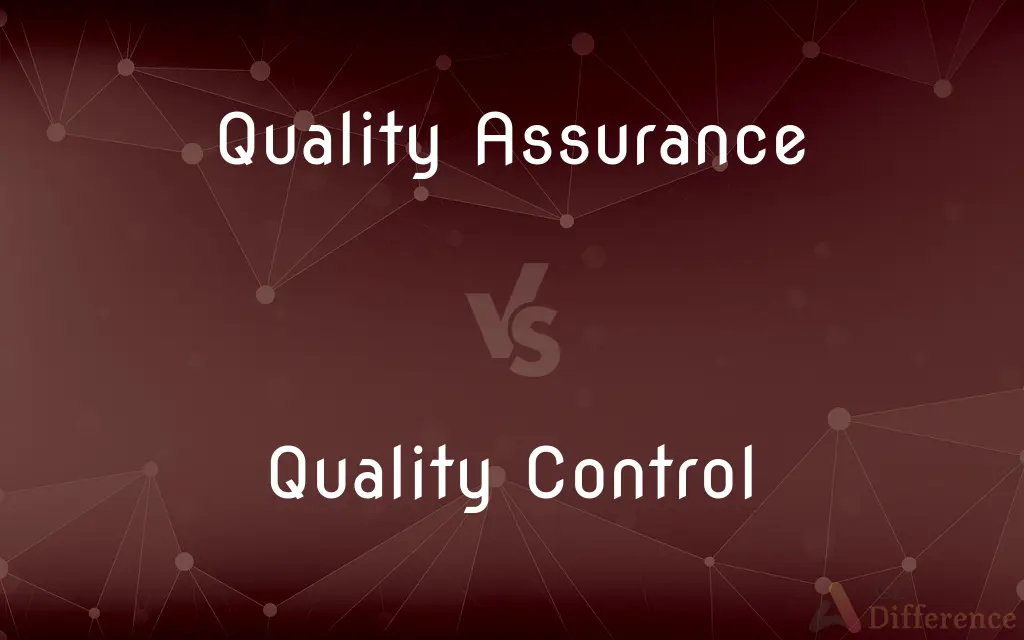Quality Assurance vs. Quality Control — What's the Difference?
By Tayyaba Rehman — Published on October 15, 2023
Quality Assurance focuses on process optimization to prevent defects, while Quality Control involves inspecting products to identify defects. Both ensure standards are met.

Difference Between Quality Assurance and Quality Control
Table of Contents
ADVERTISEMENT
Key Differences
Quality Assurance is a proactive methodology centered on developing optimal processes and systems to avoid defects in a product or service. Conversely, Quality Control is a reactive approach, emphasizing the inspection and testing of products or services to detect and rectify any defects.
At the planning stage, Quality Assurance ensures that systems are designed to meet or exceed a set standard, facilitating the creation of high-quality products. In contrast, Quality Control comes into play after the product has been developed, assessing its actual quality level and ensuring it meets the defined standards.
In essence, Quality Assurance aims to instill confidence that quality requirements will be fulfilled. It is about ensuring the "right process" is in place. On the other hand, Quality Control aims to identify and correct defects in the finished product, ensuring the "right result" has been achieved.
Quality Assurance is holistic, taking into account the entire process from inception to completion. It's about instituting a culture of quality. Quality Control, meanwhile, often zooms in on particular stages or segments, ensuring each meets the quality threshold.
It's critical to recognize that while both Quality Assurance and Quality Control have their distinct roles, they are complementary. While Quality Assurance ensures a product is made correctly, Quality Control confirms that the result is as expected.
ADVERTISEMENT
Comparison Chart
Primary Focus
Process optimization to prevent defects.
Inspection and testing to detect defects.
Stage of Implementation
Throughout the process, mainly in the planning phase.
After product development, during the inspection phase.
Nature
Proactive.
Reactive.
Goal
Ensure the right process is in place.
Ensure the right result has been achieved.
Scope
Holistic, entire process.
Specific stages or segments of a process.
Compare with Definitions
Quality Assurance
A proactive approach to ensure defect prevention.
Their Quality Assurance team revamped the manufacturing process to improve efficiency.
Quality Control
A reactive approach that identifies and rectifies defects.
Through rigorous Quality Control, they identified flaws in the final batch.
Quality Assurance
Aims at instilling confidence in meeting quality requirements.
Quality Assurance protocols guaranteed that the delivered software was free of critical bugs.
Quality Control
Focuses on specific stages or segments of a process.
Quality Control technicians examined the assembly line for potential issues.
Quality Assurance
About instituting a culture of quality.
Quality Assurance initiatives elevated the brand's reputation in the market.
Quality Control
Aims at confirming the end result is as expected.
Quality Control measures verified that the drug's potency was within acceptable limits.
Quality Assurance
Ensures systems are designed to meet set standards.
With Quality Assurance in place, the company reduced product returns significantly.
Quality Control
Ensures finished products meet the defined standards.
Regular Quality Control checks ensured consistent product quality.
Quality Assurance
The methodology focusing on optimal process design.
Quality Assurance was crucial in establishing a robust software development lifecycle.
Quality Control
Emphasizes product inspection and testing.
Their Quality Control department rejected items that didn't meet the criteria.
Quality Control
A system for ensuring the maintenance of proper standards in manufactured goods, especially by periodic random inspection of the product.
Common Curiosities
Is Quality Assurance about detecting defects in products?
No, Quality Assurance is about preventing defects by optimizing processes.
Is Quality Control only about testing products?
While testing is a significant component, Quality Control encompasses all activities that ensure a product meets specified criteria.
Which one is more about the process: Quality Assurance or Quality Control?
Quality Assurance is more about the process, ensuring it's designed to produce quality results.
Why is Quality Assurance considered proactive?
Because it focuses on establishing the right processes to prevent defects from arising.
Do Quality Assurance measures guarantee a defect-free product?
While Quality Assurance minimizes the chance of defects, no system can guarantee a 100% defect-free product.
When is Quality Control typically implemented?
Quality Control is implemented after product development, during the inspection phase.
Can a company have both Quality Assurance and Quality Control?
Yes, many companies use both Quality Assurance and Quality Control as complementary practices.
Can a product that passed Quality Assurance checks still have defects?
Yes, while Quality Assurance reduces defects, some might still arise, highlighting the need for Quality Control.
Which department typically handles Quality Control checks?
Quality Control is usually overseen by a dedicated Quality Control or Quality department.
Is Quality Control only done at the end of a process?
While often at the end, Quality Control can occur at any stage where quality checks are deemed necessary.
Share Your Discovery

Previous Comparison
Biological Control vs. Chemical Control
Next Comparison
Over Subscription vs. Under SubscriptionAuthor Spotlight
Written by
Tayyaba RehmanTayyaba Rehman is a distinguished writer, currently serving as a primary contributor to askdifference.com. As a researcher in semantics and etymology, Tayyaba's passion for the complexity of languages and their distinctions has found a perfect home on the platform. Tayyaba delves into the intricacies of language, distinguishing between commonly confused words and phrases, thereby providing clarity for readers worldwide.
















































